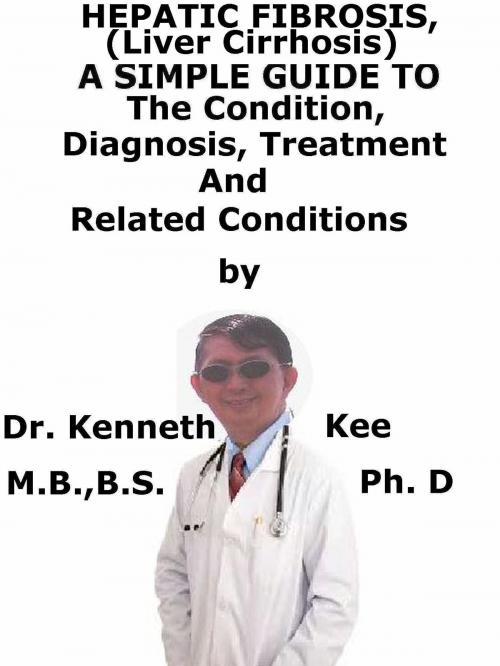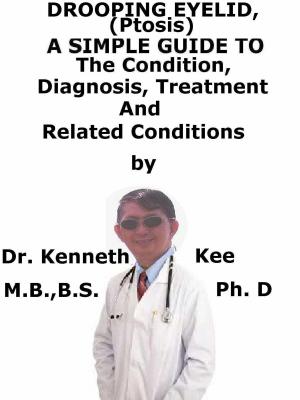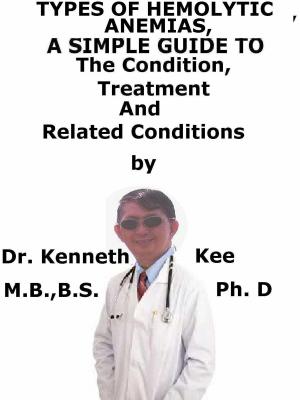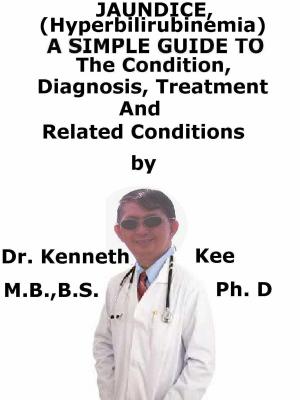Hepatic Fibrosis, (Liver Cirrhosis) A Simple Guide To The Condition, Diagnosis, Treatment And Related Conditions
Nonfiction, Health & Well Being, Health, Ailments & Diseases, Abdominal, Medical| Author: | Kenneth Kee | ISBN: | 9781370168736 |
| Publisher: | Kenneth Kee | Publication: | December 29, 2017 |
| Imprint: | Smashwords Edition | Language: | English |
| Author: | Kenneth Kee |
| ISBN: | 9781370168736 |
| Publisher: | Kenneth Kee |
| Publication: | December 29, 2017 |
| Imprint: | Smashwords Edition |
| Language: | English |
This book describes Hepatic Fibrosis, Diagnosis and Treatment and Related Diseases
Hepatitis fibrosis is a better word to describe the scar tissue and nodules that replace liver tissue and disrupt liver function than Liver Cirrhosis (derived from Greek kirrhós meaning "yellowish, tawny" the orange-yellow color of the diseased liver).
The disorder fibrosis is the formation of fibrous connective tissue as a repairing response to injury or injury.
Fibrosis may refer to the connective tissue deposition that happens as part of normal healing or to the excess tissue deposition that happens as a pathological process.
When fibrosis happens in reaction to damage, the word “scarring” is used.
Singapore scientists have found that a protein, Interleukin 11, or IL11, causes fibrosis disease, which can lead to life-threatening disorders.
The discovery paves the way for more effective treatment against fibrosis, where the body produces excessive connective tissue in response to an injury, causing tissue scarring.
Hepatic Fibrosis (Liver cirrhosis)
Hepatic Fibrosis indicates the scar tissue and nodules that replace liver tissue and disrupt liver function.
The disorder is normally caused by alcoholism, fatty liver disease, hepatitis B or hepatitis C but in USA hepatitis C has become the main cause.
The liver is accountable for several essential functions such detoxifying certain materials in the body, producing essential nutrients and cleaning the blood.
Each time the liver undergoes stress or injury, it tries to regenerate and produces scar tissue in the process.
When the scar tissue accumulates, liver function becomes worse and when cirrhosis is advanced, the liver no longer works properly.
Hepatic Fibrosis does not show any symptoms until the injury has become extensive, at which point it may cause a wide range of symptoms.
a. Tendency to bleed or bruise early
b. Fatigue
c. Jaundice or yellowing of the skin and eyes
d. Ascites or fluid build up in the abdomen
e. Weight loss
f. Itchy skin
g. Nausea
h. Swelling in the legs
i. Disorientation and drowsiness
j. Slurred speech
k. The development of spider-like vessels underneath the skin surface
Hepatic Fibrosis (Liver Cirrhosis) is a chronic liver disease where the normal liver tissue is replaced by bands of fibrous scar tissue separating nodules of regenerated liver cells leading to gradual loss of liver function.
It is likely to progress gradually and often does not produce any symptoms in its early stages.
When the function of the liver slowly becomes worse, serious complications can develop.
Diagnosis:
A doctor may detect that the liver is enlarged or that the patient is retaining fluid.
An ultrasound scan (or a CT or MRI scan) may show that the patient has a damaged liver.
If Hepatic Fibrosis (Liver Cirrhosis) is detected and diagnosed during the early stages of disease, any further damage to the liver may be prevented.
Treatment depends on the stage of disease and the underlying cause of the cirrhosis, but the overall goal is to slow disease progression and relieve symptoms.
This might be these approaches:
a. Treating alcohol dependency, often through rehabilitation programs for alcohol addicts
b. Weight loss plans for people with cirrhosis caused by non¬alcoholic fatty liver disease
c. Medicine that can help prevent liver damage caused by hepatitis B or C
d. Drugs to alleviate symptoms such as pain, tiredness and itching
When Hepatic Fibrosis (Liver Cirrhosis) is advanced, a liver transplant using a donor organ may be the only method for some patients.
A patient who is about to receive a liver transplant needs to go through extensive testing to ensure they are healthy enough to go through the procedure.
TABLE OF CONTENT
Introduction
Chapter 1 Hepatic Fibrosis
Chapter 2 Causes
Chapter 3 Symptoms
Chapter 4 Diagnosis
Chapter 5 Treatment
Chapter 6 Prognosis
Chapter 7 Hepatitis
Chapter 8 Alcoholism
Epilogue
This book describes Hepatic Fibrosis, Diagnosis and Treatment and Related Diseases
Hepatitis fibrosis is a better word to describe the scar tissue and nodules that replace liver tissue and disrupt liver function than Liver Cirrhosis (derived from Greek kirrhós meaning "yellowish, tawny" the orange-yellow color of the diseased liver).
The disorder fibrosis is the formation of fibrous connective tissue as a repairing response to injury or injury.
Fibrosis may refer to the connective tissue deposition that happens as part of normal healing or to the excess tissue deposition that happens as a pathological process.
When fibrosis happens in reaction to damage, the word “scarring” is used.
Singapore scientists have found that a protein, Interleukin 11, or IL11, causes fibrosis disease, which can lead to life-threatening disorders.
The discovery paves the way for more effective treatment against fibrosis, where the body produces excessive connective tissue in response to an injury, causing tissue scarring.
Hepatic Fibrosis (Liver cirrhosis)
Hepatic Fibrosis indicates the scar tissue and nodules that replace liver tissue and disrupt liver function.
The disorder is normally caused by alcoholism, fatty liver disease, hepatitis B or hepatitis C but in USA hepatitis C has become the main cause.
The liver is accountable for several essential functions such detoxifying certain materials in the body, producing essential nutrients and cleaning the blood.
Each time the liver undergoes stress or injury, it tries to regenerate and produces scar tissue in the process.
When the scar tissue accumulates, liver function becomes worse and when cirrhosis is advanced, the liver no longer works properly.
Hepatic Fibrosis does not show any symptoms until the injury has become extensive, at which point it may cause a wide range of symptoms.
a. Tendency to bleed or bruise early
b. Fatigue
c. Jaundice or yellowing of the skin and eyes
d. Ascites or fluid build up in the abdomen
e. Weight loss
f. Itchy skin
g. Nausea
h. Swelling in the legs
i. Disorientation and drowsiness
j. Slurred speech
k. The development of spider-like vessels underneath the skin surface
Hepatic Fibrosis (Liver Cirrhosis) is a chronic liver disease where the normal liver tissue is replaced by bands of fibrous scar tissue separating nodules of regenerated liver cells leading to gradual loss of liver function.
It is likely to progress gradually and often does not produce any symptoms in its early stages.
When the function of the liver slowly becomes worse, serious complications can develop.
Diagnosis:
A doctor may detect that the liver is enlarged or that the patient is retaining fluid.
An ultrasound scan (or a CT or MRI scan) may show that the patient has a damaged liver.
If Hepatic Fibrosis (Liver Cirrhosis) is detected and diagnosed during the early stages of disease, any further damage to the liver may be prevented.
Treatment depends on the stage of disease and the underlying cause of the cirrhosis, but the overall goal is to slow disease progression and relieve symptoms.
This might be these approaches:
a. Treating alcohol dependency, often through rehabilitation programs for alcohol addicts
b. Weight loss plans for people with cirrhosis caused by non¬alcoholic fatty liver disease
c. Medicine that can help prevent liver damage caused by hepatitis B or C
d. Drugs to alleviate symptoms such as pain, tiredness and itching
When Hepatic Fibrosis (Liver Cirrhosis) is advanced, a liver transplant using a donor organ may be the only method for some patients.
A patient who is about to receive a liver transplant needs to go through extensive testing to ensure they are healthy enough to go through the procedure.
TABLE OF CONTENT
Introduction
Chapter 1 Hepatic Fibrosis
Chapter 2 Causes
Chapter 3 Symptoms
Chapter 4 Diagnosis
Chapter 5 Treatment
Chapter 6 Prognosis
Chapter 7 Hepatitis
Chapter 8 Alcoholism
Epilogue















